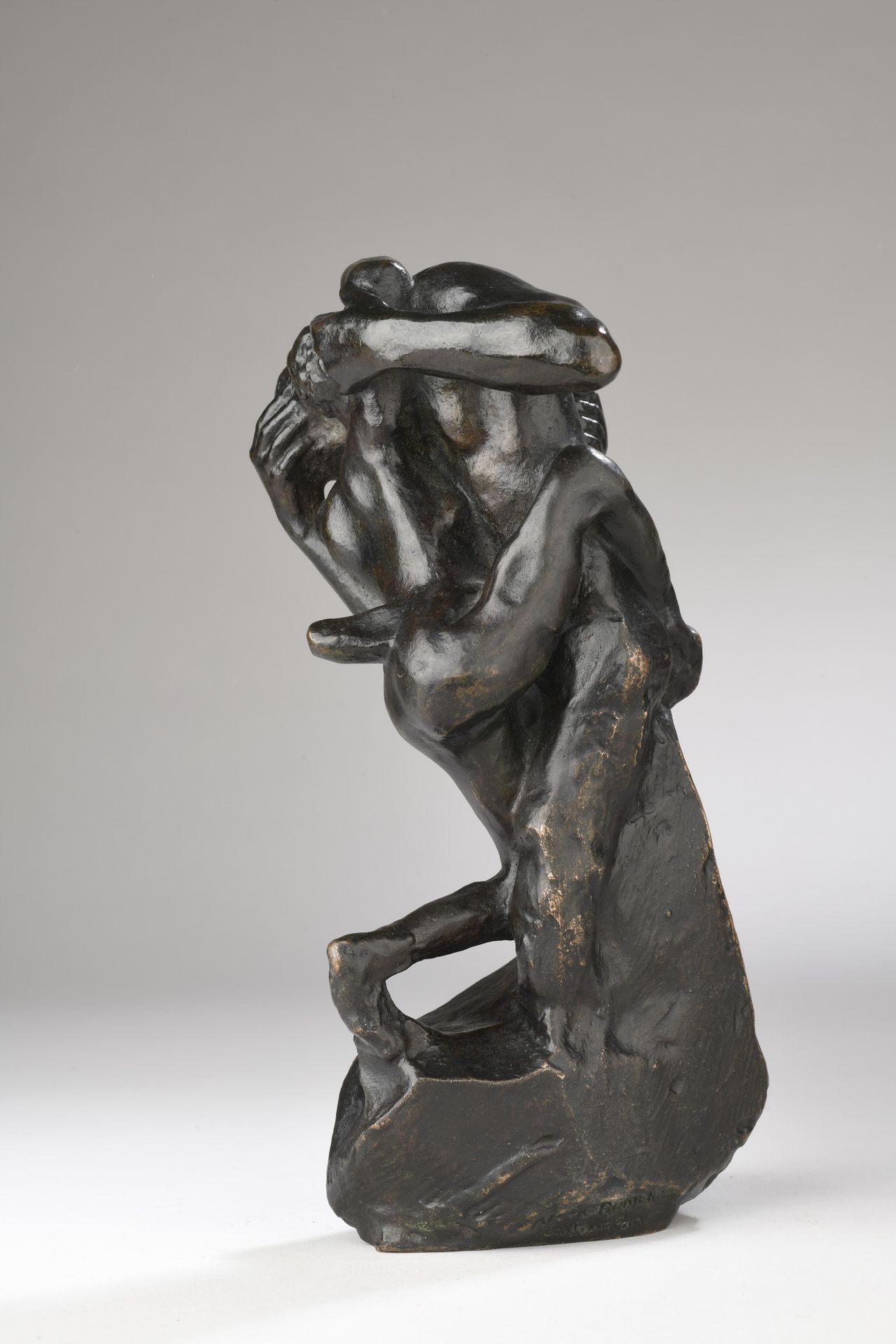Description
Auguste Rodin (1840-1917) Sin, circa 1895-1898 ? Proof in bronze with black patina shaded green and blue, no. 2 Alexis Rudier sand casting executed in 1930, marked "Alexis RUDIER / Fondeur Paris". Signed: "A. Rodin". Inside the work: Rodin stamp 22.8 x 11.7 x 11.7 cm Provenance : Musée Rodin, Paris Dr. Kauffmann (acquired from previous owner, February 1943) Private collection, France (acquired by reputation in 1950-1960) By descent Related literature : - Antoinette Le Normand-Romain, Rodin et le bronze, Catalogue des œuvres conservées au musée Rodin, RMN / Musée Rodin, 2007, p. 582-583. A notice of inclusion in the critical catalog of Rodin's sculpted works, issued by the Comité Rodin, will be given to the purchaser. Entitled La Victoire by Otto Grautoff in 1908, and sometimes confused with L'Emprise, another group bearing this name, Le Péché is to be compared with these groups dated around 1895-1899 by Antoinette Le Normand-Romain, Rodin specialist and former curator at the Musée Rodin (Rodin et le bronze, 2007). More spirited than the Eternal Idol group, Le Péché is a small, highly erotic group, expressing the concentrated passion between man and woman more intensely than the Emprise group. Rodin presented Le Péché in Vienna in 1898, Brussels and the Netherlands in 1899, Paris in 1900 and Prague in 1902. "The female figure has been transformed into a satyr by the addition of a small tail at the base of her back, which in some plaster casts is no more than a protuberance perhaps corresponding to the end of an armature. Despite this mythological varnish, there were only a few bronze examples, including one by Carrière, who also owned the large Iris, and a marble one. The latter was mentioned as early as 1899, but executed late: it was first mentioned in 1911, when Gertrude Whitney acquired it." (Antoinette Le Normand-Romain, Rodin et le bronze, 2007). The bronze edition of Le Péché is relatively well known: - one proof was made by an undetermined caster. It belonged to the Eugène Carrière (1849-1906) collection (Sale Paris, galerie Manzi-Joyant, February 2-3 1920, no. 184). - At least six other proofs were sand-found by Alexis Rudier between 1929 and 1943. Among these bronzes made by Alexis Rudier are the one shown here, no. 2, as well as the one in the collections of the Soumaya Museum in Mexico City and the one in the Rodin Museum, no. 0. The latter was cast in 1930 "for exhibition at the museum".
112
Auguste Rodin (1840-1917) Sin, circa 1895-1898 ? Proof in bronze with black patina shaded green and blue, no. 2 Alexis Rudier sand casting executed in 1930, marked "Alexis RUDIER / Fondeur Paris". Signed: "A. Rodin". Inside the work: Rodin stamp 22.8 x 11.7 x 11.7 cm Provenance : Musée Rodin, Paris Dr. Kauffmann (acquired from previous owner, February 1943) Private collection, France (acquired by reputation in 1950-1960) By descent Related literature : - Antoinette Le Normand-Romain, Rodin et le bronze, Catalogue des œuvres conservées au musée Rodin, RMN / Musée Rodin, 2007, p. 582-583. A notice of inclusion in the critical catalog of Rodin's sculpted works, issued by the Comité Rodin, will be given to the purchaser. Entitled La Victoire by Otto Grautoff in 1908, and sometimes confused with L'Emprise, another group bearing this name, Le Péché is to be compared with these groups dated around 1895-1899 by Antoinette Le Normand-Romain, Rodin specialist and former curator at the Musée Rodin (Rodin et le bronze, 2007). More spirited than the Eternal Idol group, Le Péché is a small, highly erotic group, expressing the concentrated passion between man and woman more intensely than the Emprise group. Rodin presented Le Péché in Vienna in 1898, Brussels and the Netherlands in 1899, Paris in 1900 and Prague in 1902. "The female figure has been transformed into a satyr by the addition of a small tail at the base of her back, which in some plaster casts is no more than a protuberance perhaps corresponding to the end of an armature. Despite this mythological varnish, there were only a few bronze examples, including one by Carrière, who also owned the large Iris, and a marble one. The latter was mentioned as early as 1899, but executed late: it was first mentioned in 1911, when Gertrude Whitney acquired it." (Antoinette Le Normand-Romain, Rodin et le bronze, 2007). The bronze edition of Le Péché is relatively well known: - one proof was made by an undetermined caster. It belonged to the Eugène Carrière (1849-1906) collection (Sale Paris, galerie Manzi-Joyant, February 2-3 1920, no. 184). - At least six other proofs were sand-found by Alexis Rudier between 1929 and 1943. Among these bronzes made by Alexis Rudier are the one shown here, no. 2, as well as the one in the collections of the Soumaya Museum in Mexico City and the one in the Rodin Museum, no. 0. The latter was cast in 1930 "for exhibition at the museum".
